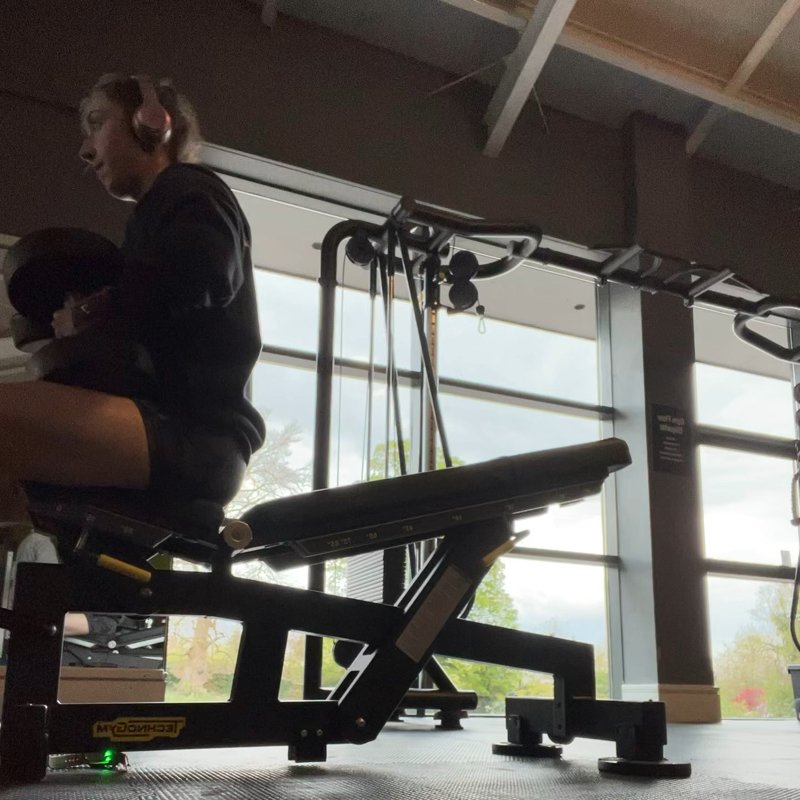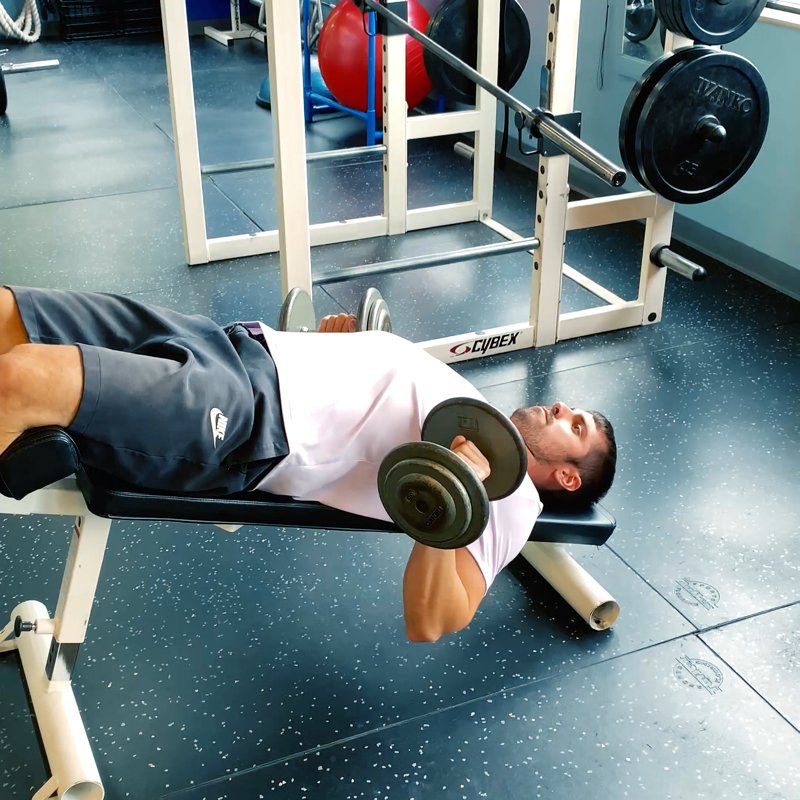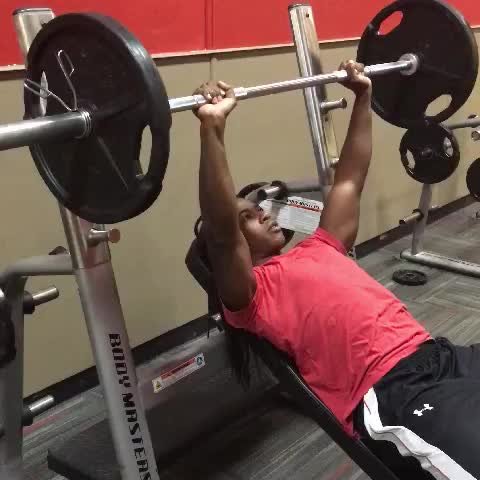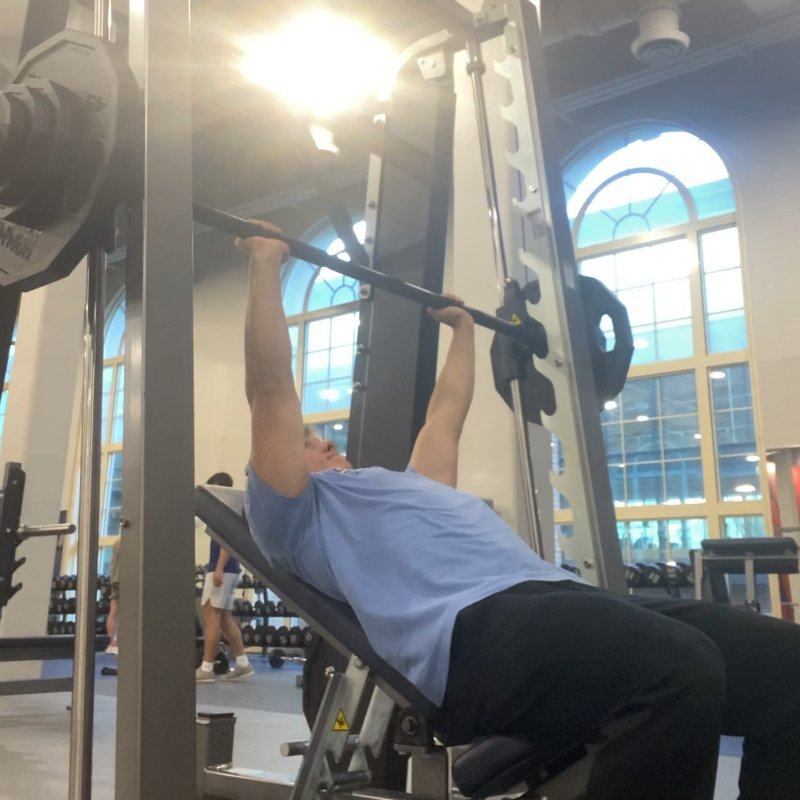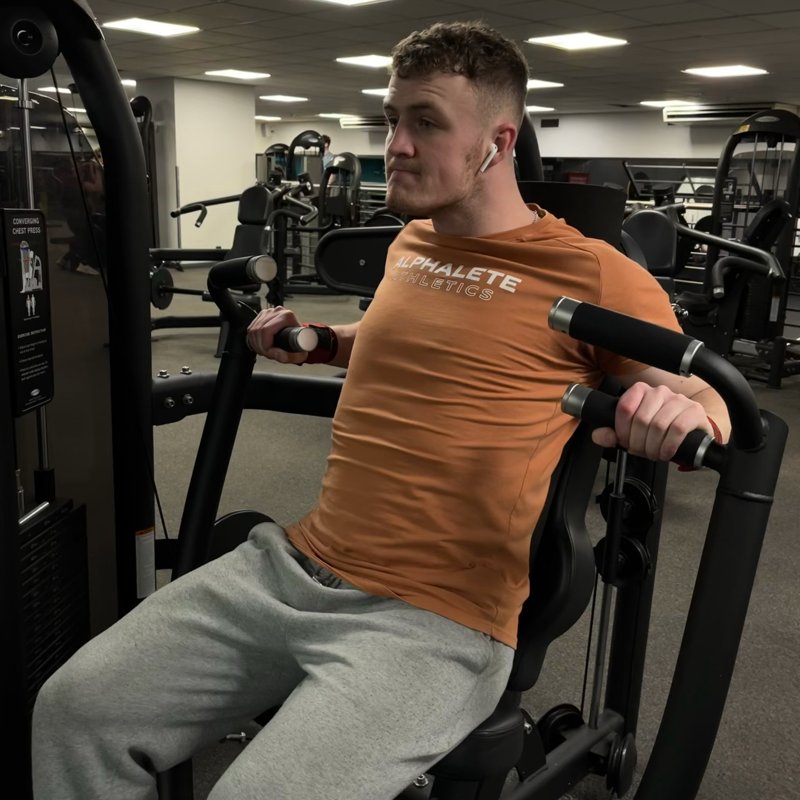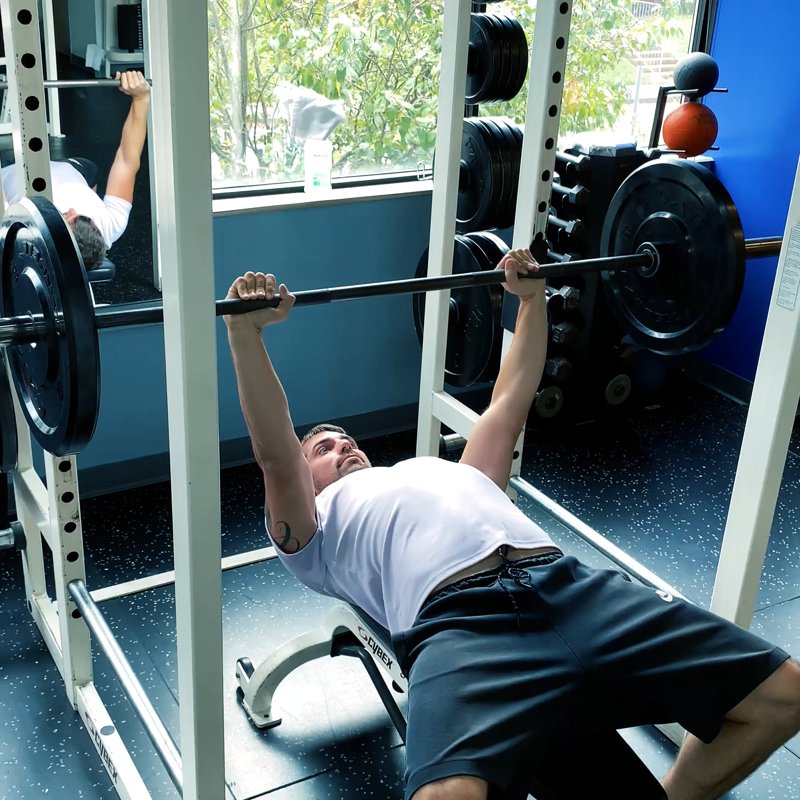Dumbbell Bench Press: The Ultimate Guide
The Dumbbell Bench Press is a versatile compound exercise that targets the chest, shoulders, and triceps while offering unique benefits over the barbell version, including greater range of motion, improved muscle balance, and reduced shoulder stress.
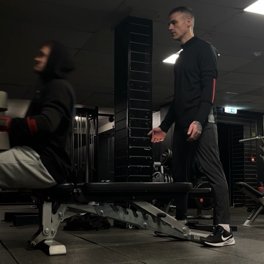
Quick Facts
Key Benefit
Balanced chest development with increased range of motion
Primary Muscles
Anterior Deltoids, Pectoralis Major, Triceps
Secondary Muscles
Abdominals, Pectoralis Minor, Rotator Cuff
Equipment
dumbbells, flat bench
Difficulty
Intermediate
Type
Strength
In This Guide
Ready to master the Dumbbell Bench Press?
Track your progress, see improvements over time, and build strength consistently.
Download GravitusThe Dumbbell Bench Press is a fundamental upper body exercise that offers several unique advantages over its barbell counterpart. While both exercises effectively target the chest muscles, the independent nature of dumbbells creates distinct benefits that make this variation especially valuable for balanced development. By using separate weights for each arm, the dumbbell bench press prevents stronger sides from compensating for weaker ones, leading to more symmetrical strength and development. This unilateral component also engages more stabilizing muscles, as each arm must control its weight independently. Additionally, dumbbells allow for a greater range of motion than a barbell. You can lower the weights deeper, creating a more effective stretch in the chest muscles, and you can bring them closer together at the top, achieving a stronger peak contraction. For many lifters, especially those with shoulder issues, the dumbbell bench press offers another significant advantage: the ability to rotate the wrists naturally throughout the movement. This freedom allows for a more joint-friendly pressing path compared to the fixed position required by a barbell. Whether used as your primary chest exercise or as a complement to barbell work, the dumbbell bench press deserves a place in virtually any upper body training program.
Benefits of the Dumbbell Bench Press
The dumbbell bench press offers several distinct advantages that make it valuable for all levels of fitness enthusiasts.
Muscle Balance Development
Independent movement of each arm prevents strength imbalances and ensures both sides develop equally, unlike barbell variations where the dominant side can compensate.
Greater Range of Motion
Allows for a deeper stretch at the bottom position and a more complete contraction at the top compared to barbell pressing.
Shoulder-Friendly Pressing
Freedom to rotate the wrists and find a natural pressing path can reduce shoulder stress for many lifters compared to the fixed position of a barbell.
Enhanced Stabilizer Recruitment
The need to control two separate weights engages more stabilizing muscles in the shoulders, arms, and core.
No Spotter Required
Unlike heavy barbell bench pressing, dumbbells can be safely dropped to the sides in case of failure, making it more suitable for solo training.
Proper Form & Technique
Setup
- Select appropriate dumbbells that allow you to maintain proper form throughout the set.
- Set the bench to a flat position and ensure it's stable on the floor.
- Place the dumbbells at the end of the bench where your head will be positioned.
- Sit at the end of the bench, dumbbells resting on your thighs.
- Lean back while using your thighs to help kick the weights up to their starting position.
- Position yourself with your eyes directly under the weights, head, upper back, and glutes in contact with the bench.
- Plant your feet firmly on the floor, slightly wider than shoulder-width for stability.
Starting Position
- Hold the dumbbells at the sides of your chest, elbows bent and pointing outward at approximately a 45-degree angle from your torso.
- Position the dumbbells just outside and slightly above your chest, palms facing forward or slightly inward.
- Retract your shoulder blades (pinch them together and down) to create a stable platform and protect your shoulders.
- Maintain a natural arch in your lower back with your core engaged to stabilize your torso.
- Ensure your wrists are in a neutral position, neither flexed nor extended, with the dumbbells aligned with your forearms.
Movement
- Take a deep breath and brace your core before initiating the press.
- Press the dumbbells upward in a slight arc, bringing them together at the top of the movement.
- At the top position, the dumbbells should be directly over your shoulders, arms extended but not fully locked out.
- Pause briefly at the top, focusing on contracting your chest muscles.
- Slowly lower the weights in a controlled manner, following the same arcing path back to the starting position.
- Allow for a full stretch in the chest at the bottom position without excessive shoulder extension.
- Exhale during the pushing phase and inhale during the lowering phase.
- Repeat for the desired number of repetitions, maintaining control throughout.
Key Form Tips
Elbow Position
Keep elbows at approximately 45-70 degrees from your torso, not flared completely out (90 degrees) to reduce shoulder stress.
Dumbbell Path
Follow a slight arcing path rather than a perfectly vertical one, moving from chest level to directly over the shoulders.
Wrist Alignment
Maintain straight wrists throughout the movement, with dumbbells aligned with your forearms to prevent wrist strain.
Bench Contact
Keep your head, upper back, and glutes in contact with the bench throughout the exercise.
Foot Placement
Plant feet firmly on the floor to provide stability and allow for leg drive when needed.
Muscles Worked
Primary Muscles
- pectoralis major: The large chest muscle responsible for the pressing movement, particularly the sternal (middle and lower) portion.
- anterior deltoids: The front portion of the shoulder muscles assists significantly in the pressing motion.
- triceps: The three-headed muscle on the back of the upper arm extends the elbow during the press.
Secondary Muscles
- pectoralis minor: Located along the ribs under the armpit, this muscle stabilizes the shoulder blade and assists with the finishing motion at the top of the press.
- rotator cuff: These small muscles around the shoulder joint (supraspinatus, infraspinatus, teres minor, and subscapularis) work to stabilize the shoulder during the movement.
- serratus anterior: A smaller chest muscle that lies beneath the pectoralis major and assists in shoulder movement.
- abdominals: The abdominals and lower back muscles work isometrically to stabilize the torso throughout the pressing motion.
Common Mistakes and How to Fix Them
Bouncing Dumbbells Off Chest
Using momentum by bouncing the weights off your chest reduces muscle tension and increases injury risk. Fix this by controlling the descent, lightly touching the dumbbells to your chest, and pressing from a brief pause rather than a bounce.
Excessive Elbow Flare
Keeping elbows at 90 degrees to your body (fully flared) places unnecessary stress on the shoulder joints. Maintain elbows at a 45-70 degree angle relative to your torso to reduce shoulder strain while effectively targeting the chest.
Arching Lower Back Excessively
An extreme arch might help lift more weight but can strain the lower back. Maintain a natural arch with your lower back supported by keeping your feet firmly on the floor and your core engaged throughout the movement.
Insufficient Range of Motion
Not lowering the dumbbells enough or failing to extend arms sufficiently at the top reduces effectiveness. Allow for a full stretch at the bottom (dumbbells at chest level) and a complete extension (without elbow locking) at the top for maximum muscle development.
Using Momentum to Start Repetitions
Jerking or heaving to initiate the pressing movement reduces muscle engagement and control. Begin each repetition from a controlled starting position, focusing on generating force from the chest muscles rather than momentum.
Dumbbell Bench Press Variations
Bench Angle Variations
-
Incline Dumbbell Press
Performed on a bench set to approximately 30-45 degrees, this variation shifts emphasis to the upper chest and anterior deltoids.
-
Decline Dumbbell Press
Using a bench set to a downward angle, this targets the lower portion of the chest more directly.
-
Alternating Dumbbell Press
Pressing one dumbbell at a time while holding the other at the bottom position, increasing core involvement and unilateral control.
Technical Variations
-
Neutral Grip Dumbbell Press
Keeping palms facing each other throughout the movement (also called hammer press), which can be more shoulder-friendly for some lifters.
-
Close Grip Dumbbell Press
Keeping the dumbbells closer together during the press, increasing triceps involvement while still targeting the chest.
-
Tempo Dumbbell Press
Manipulating the speed of different phases (e.g., 3 seconds down, 1 second pause, explosive up) to increase time under tension and muscle stimulus.
Frequently Asked Questions
Neither is universally "better" - they each have distinct advantages. Dumbbell bench presses offer greater range of motion, more balanced development between sides, natural wrist rotation, and can be more shoulder-friendly for many lifters. Barbell bench presses typically allow for heavier total loads, simpler progressive overload tracking, and may be better for absolute strength development. Most well-designed programs incorporate both variations for complete development. If shoulder health is a concern, many lifters find dumbbells more comfortable. For pure strength performance, the barbell version is typically preferred. For balanced muscle development, the dumbbell version offers unique benefits.
A common guideline is that most lifters can dumbbell press approximately 80% of their barbell bench press weight, divided between two dumbbells. For example, someone who barbell benches 200 pounds might use a pair of 80-pound dumbbells (160 pounds total). However, this varies considerably based on individual leverages, experience with dumbbells, and shoulder mobility. Rather than comparing to specific weight standards, focus on progressive overload relative to your own performance. If you're new to dumbbell pressing, start conservatively and gradually increase as your stabilizer strength and coordination improve.
Yes, you can build significant chest development using only dumbbell bench presses, especially when performed through a full range of motion with appropriate loading. Many successful bodybuilders and physique athletes rely heavily on dumbbell work for chest development. For complete development, consider including variations like incline and decline presses to target all portions of the chest. While a barbell isn't strictly necessary for chest development, incorporating multiple pressing angles, rep ranges, and occasionally other chest-focused movements (like flies or push-ups) will lead to more comprehensive development.
For heavier dumbbells, use this technique - first, sit at the end of the bench with dumbbells positioned vertically on your thighs. Then lean back while simultaneously driving the weights up with your knees/thighs, guiding them into position with your arms. As you reach the lying position, rotate your wrists to the pressing position. For very heavy weights, consider asking for a spotter to help hand you the dumbbells when you are already in position. When finishing your set, do not drop the weights straight down - lower them with control to the sides of your chest, then lower them to the floor or redirect them to your thighs if sitting up.
Video Demonstrations
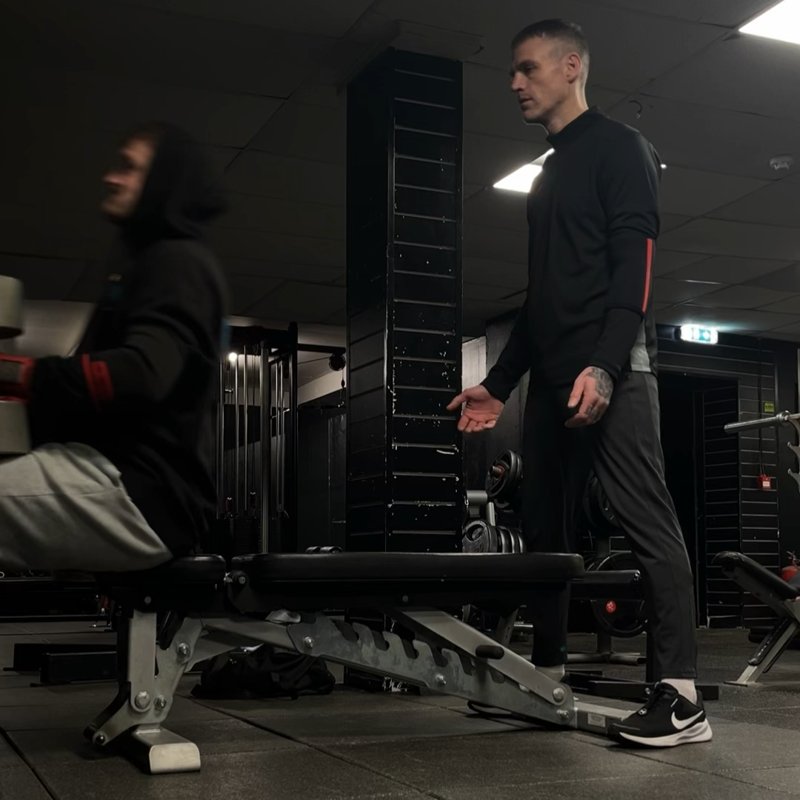
Log in to watch video demonstrations
Login to Watch3 video demonstrations available
Find more video demonstrations in the Gravitus app
Tips from the Community
-

Do not do it on a phisioball
-

Preform in squat rack to assert alphaness
-

Perform on 4 bosu balls for optimal calf engagement
-

Tuck your elbows in and let your shoulder blades move naturally instead of forcing them to stay pinned back
-

Can also be done on a physioball for an added stability challenge
Track your progress with Gravitus
Download Gravitus to log your workouts, track your progress, and join a community of fitness enthusiasts.

Helpful Resources
One Rep Max Calculator
Find your one rep max for any exercise without maximal testing. Essential for developing effective strength training programs.
Calculate 1RMWorkout Programs
Follow structured workout programs created by fitness professionals to maximize your strength and muscle gains.
View Programs